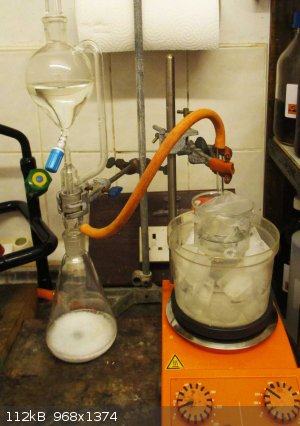Rhodanine and the alcoholic ammonia saga
I required some rhodanine for the preparation of various derivatives that I wish to prepare. There are two basic methods of preparing rhodanine, those
using a thiocyanate salts and those that use ammonium dithiocarbamate as the source of sulphur. The former methods are typified by the original
synthesis of Nencki 1) which uses the rather vigorous reaction between chloroacetic acid and ammonium thiocyanate. I tried this method and it works;
it is rapid and simple but the yield is poor and the product discoloured. The discolouration is difficult to remove though it can be done. The more
elegant method is that of Redemann et al. 2) given in Organic Syntheses. This multistage synthesis starts with the preparation of the ammonium
dithiocarbamate from an alcoholic ammonia solution and carbon disulphide and this is where the problems arise.
I have recently attempted this reaction several times with somewhat variable success and I will describe these in a separate post but for now I wish
to concentrate on the preparation of that tricky alcoholic ammonia solution. In the Org. Synth. preparation they simply state: “Gaseous ammonia is
passed into 250ml of 95% ethanol contained in a 1-L Erlenmeyer flask immersed in an ice bath until the gain in weight is 39g.”
Easy peasy I here you say. Like hell it is!
First of all you have to set up a reliable source of ammonia gas capable of generating ammonia at a very steady, controlled rate for many hours as the
absorption of ammonia by ethanol is much slower than is the case with water. Then the alcohol must be kept cool for this period (lots of ice) and
finally there is the weight gain issue. The later problem is not the periodic dismantling of the system to weigh the receiving flask but the curious
tendency for the weight gain to reach a maximum and then start to decline in spite of the apparent continuing absorption of ammonia gas. I have found
that after a weight gain of about 28g the weight begins to fall again. I can only assume that this is the point where weight gain is less than
evaporation of alcohol/ammonia. Topping up the alcohol level is tricky too since there is a considerable increase in volume accompanying the
absorption of the ammonia (about 40-50ml to the maximum weight).
Generating ammonia gas at a constant rate over long periods was fraught too. I tried numerous methods including NaOH + ammonium chloride solids and
adding water, this works but requires stirring which is difficult with a magnetic type stirrer; saturated ammonium sulphate solution + solid calcium
hydroxide, this is the most economical method but it requires heating. It also requires mixing and a magnetic stirrer just can’t do it. I finally
settled for concentrated ammonia solution and solid sodium hydroxide.
In this latter method concentrated ammonia (33% S.G. of 0.9g/cc) is simply dropped slowly from a pressure equalizing funnel into a flask containing
sodium hydroxide prills. I have found that for this reaction 220ml of ammonia solution to about 150g of sodium hydroxide prills seem to be about
right, generating about 60g of ammonia (a 50% excess). No stirring is required because the sodium hydroxide slowly dissolves into the ammonia solution
displacing the ammonia gas and results in a homogeneous solution. After an initial vigorous reaction it quickly settles down with a small pool of
liquid in the middle of the sodium hydroxide prills that slowly eats into the remaining prills over several hours, the narrow reaction front limiting
the rate of ammonia evolutions. By controlling the rate of addition of the ammonia solution it is possible to maintain a steady supply of ammonia for
at least 6 hours.
I found that an inverted funnel into the top of the ice-cold ethanol in a tall form beaker to be the simplest absorption set-up. It is possible to
control the rate of gas generation to such an extent that no gas escapes around the funnel one the air in the system has been purged.
 The set-up used to generate ammonia showing the alcohol in the ice bath, the funnel is obscured by a piece of parafilm The set-up used to generate ammonia showing the alcohol in the ice bath, the funnel is obscured by a piece of parafilm
I have yet to get to the bottom of the maximum weight gain problem, any suggestions would be appreciated.
1) Nencki; J.prakt. Chem.; (2) v16, p2 [1877]
2) Redemann et al.; Rhodanine; Organic Syntheses; Coll. Vol. 3 p763 [1955]
|